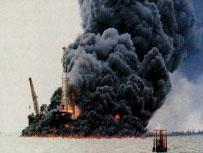There are two obvious reasons for running the casing wear program – CWPRO, which are:
1. To anticipate and then correct possible casing wear problems: and/or
2. As a post mortem analysis to determine `what happened ?’
What Happened ?
It is far better to anticipate, and then take measures to avoid, the consequences that can result from casing wear. It is also a lot less expensive. If preventive measures are omitted, the following is a sequence of events that can, and have, occurred.
- As drilling out of casing proceeds, casing wear reduces the wall thickness of a section of the casing.
- The weakened section ruptures due to the differential pressure between the heavyweight mud in the annulus between the casing and the drill pipe and the formation external to the casing.
- Drilling mud flows through the casing rupture into the formation.
- Fluid level in the annulus drops, reducing the hydrostatic pressure at all points in the annulus and open hole.
- The reduced hydrostatic pressure at (or slightly above) the bit decreases to a value less than the formation pressure.
- Lightweight formation fluid (oil and gas) can then flow from the formation into the open hole, displacing the heavier weight drilling fluid up and out.
- This further reduces hydrostatic pressure in the open hole below the intermediate casing seat, resulting in increased flow rate from the formation into the open hole.
- Formation fluids are expelled from the top of the borehole. This is the characteristic `gusher’ shown in so many pictures.
- Fairly soon, this `gusher’ can ignite, resulting in a scene similar to that shown in Figure 1.
Therefore, the ideal time to run CWPRO is as soon as possible after the well reaches casing set depth and the results of the directional survey are available. I recommend that you use the raw survey inclination and azimuth data to compute your own values of dogleg severity.
I recommend that you do not accept values of dogleg severity as a function of measured depth that you have not confirmed.
The results of the directional survey are the key ingredients for a casing wear analysis. Everything else is available to be loaded in advance. If you can, get management to authorize 30 ft (or 10 meters) station spacing, rather than the standard (and less expensive) 100 ft (or 30 meter) station spacing, it will give you a more realistic result. As we mentioned earlier in this series, a 3 degree change of borehole direction which takes place uniformly over a 100 foot interval is a lot less liable to produce serious casing wear than is the same 3 degree change which takes place over a 30 ft interval.
So now you have the drillstring specifications, the drilling program from the present casing point to the next casing point – estimated WOB, RPM and ROP values -, and the mud specifications.
What is unknown is the value of the wear factor that applies to your particular casing wear system, unless you have tested the precise casing wear system that will exist in your well. This is quite unlikely.
What we do know are the approximate range of wear factors that apply to various casing wear systems, as listed below:
- Steel tool joints, steel casings (regardless of grade), water based mud carrying sand: The wear factors for these systems range from about 3.0 to 10.0.
- Steel tool joints, steel casing (regardless of grade), oil based mud carrying sand: The wear factors for these systems range from about 1.0 to 3.0.
- Proprietary hardbanding (such as ARNCO 100 XT), steel casing (regardless of grade), water based mud carrying sand: The wear factors for these systems range from about 0.8 to 2.0.
- Steel tool joints, X – 80 riser steel, water based mud carrying sand: The wear factor for these systems range from about 30.0 to 50.0.
Now, what do we do with all this information? That comes next.

